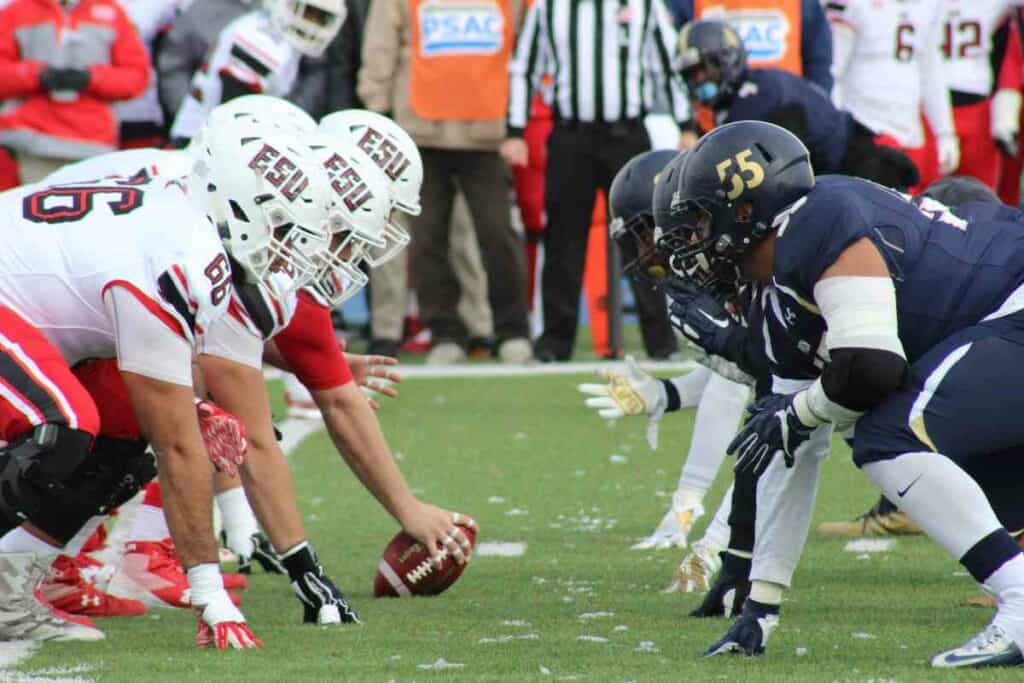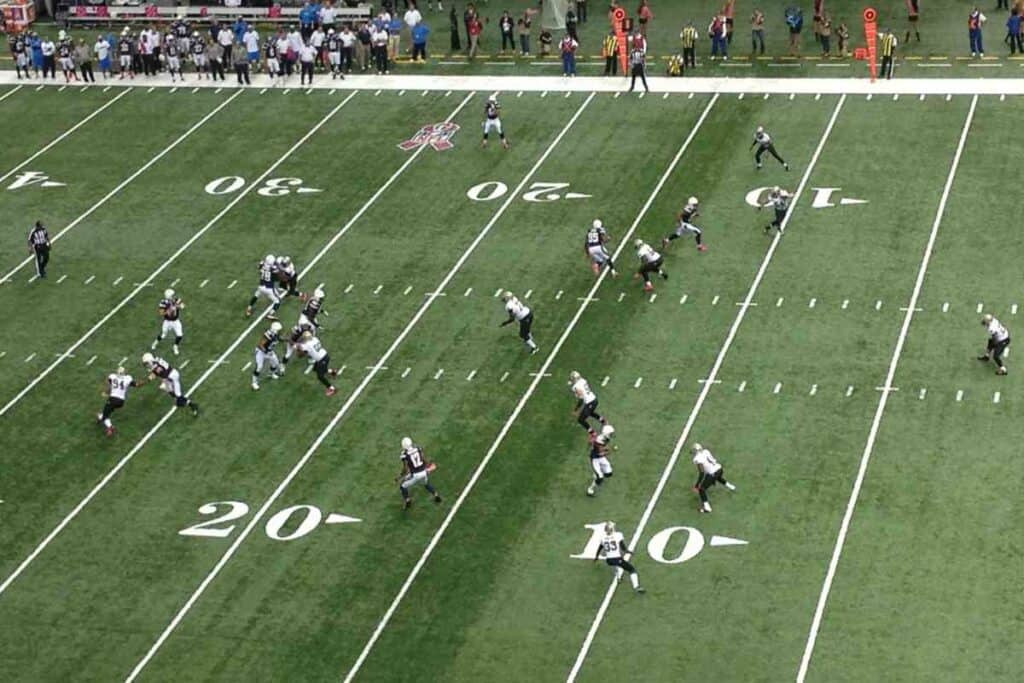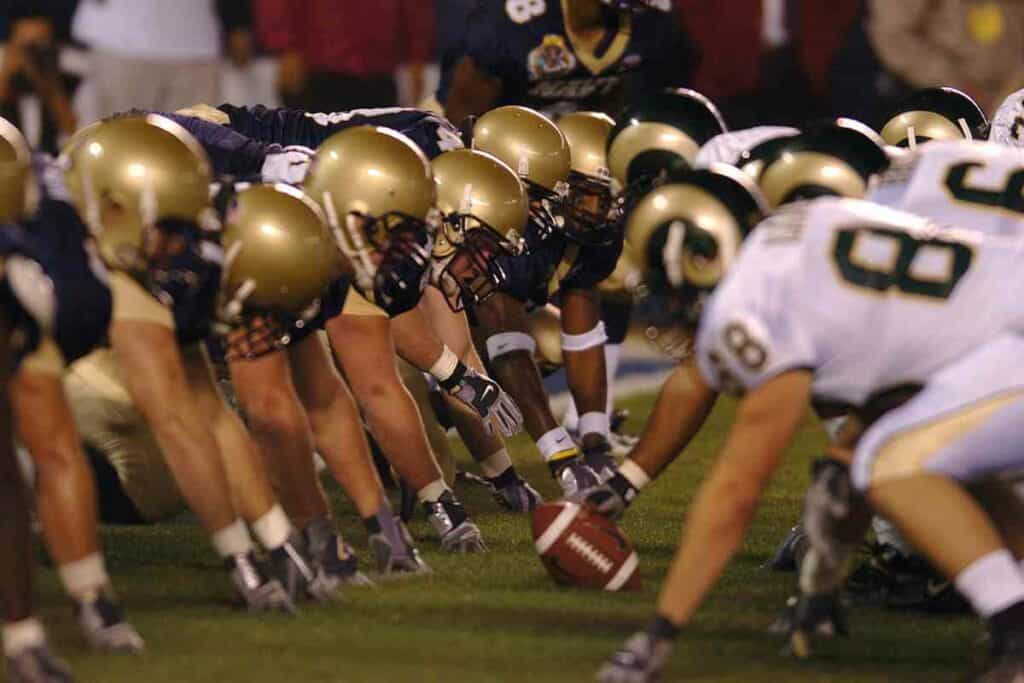What Is D3 Football: Exploring Division III College Athletics
Have you ever wondered what makes D3 football stand out in the vast landscape of college sports? At the heart of Division III football, a unique blend of athletics and academics unfolds, offering a more holistic college experience. Governed by the National Collegiate Athletic Association (NCAA), D3 football isn’t just about chasing victories on the field; it’s a celebration of academic dedication and a passion for the game.

Interested in D3 Football? Check out my related post Here’s How Much A D3 College Football Coach Makes
What Is D3 Football?
D3 football, part of NCAA Division III, emphasizes a balanced student-athlete experience, blending competitive sports with strong academic focus. Without athletic scholarships, it prioritizes educational pursuits alongside football passion. Teams compete fiercely, with players dedicated to both sport and studies, fostering personal growth and team spirit in a supportive, community-centric environment.
D3 football is distinct. It’s where the enthusiasm for sports meets the zeal for academic excellence. Unlike its counterparts in Division I and II, this division doesn’t offer athletic scholarships. Sounds surprising, right? This is because D3 emphasizes the ‘student’ in student-athlete. Here, you’ll find athletes who play driven by their love for the game, not the lure of a scholarship. Despite this, the level of competition remains intense and thrilling, reflecting the players’ dedication to both their sport and their studies.
What’s remarkable about D3 football is the variety of colleges and universities it encompasses. From quaint liberal arts schools to larger institutions, each brings its unique team culture and ethos. Yet, all share a unified commitment to fostering a well-rounded collegiate experience where sports are a part of, not the entirety of, college life.
Key Takeaways
- D3 football prioritizes a balance between athletics and academics.
- The absence of athletic scholarships in Division III underscores its non-professional, student-centric approach.
- Despite no athletic scholarships, the competition in D3 football is robust and full of heart.
Understanding NCAA Divisions
The NCAA segments colleges into divisions based on various factors like size, funding, and competitive level. Each division carves out its niche in balancing sports with educational pursuits.
- NCAA Division I: This is where you find the giants – large universities with significant athletic budgets, offering scholarships to attract the crème de la crème of athletic talent.
- NCAA Division II: Striking a more even balance between sports and studies, these institutions also offer athletic scholarships, though not as extensively as Division I.
- NCAA Division III: Here, the spotlight is on academics, with a supportive environment for student-athletes to thrive in their educational and athletic pursuits, sans athletic scholarships.
The Philosophy of Division III
Division III’s philosophy is all about enriching your college journey. It’s about academic rigor, engaging in campus life, and the thrill of playing competitive sports. It’s an invitation to grow not just as an athlete but as a well-rounded individual who’s active in various facets of campus life.

Comparing Divisions: A Snapshot
- Scholarships: A stark contrast to D-I and D-II, D-III focuses on need-based or academic scholarships, moving away from athletics-based financial aid.
- Athletic Commitment: D-III promotes a balanced approach, ensuring that sports complement, not dominate, your college experience.
- Level of Competition: While D-III games brim with competitiveness, the division steers clear of the athletic scholarship-driven ethos of D-I and D-II.
Related Post! Every Football Position: A Comprehensive Guide
The Structure of D3 Football
D3 football, nestled within the NCAA, presents a distinct and fascinating world of college sports. It’s a realm where the thrill of competition meets a deep commitment to academic achievement. Let’s dive into the intricacies of this unique division, starting with its conference composition and moving on to team eligibility, and the structuring of the regular season and scheduling.
Conference Composition: More Than Just Geography
Understanding D3 football begins with a look at its conferences. Unlike other divisions, D3 places teams in conferences primarily based on geographical proximity. This strategic alignment serves a dual purpose:
- Reduced Travel: Keeping teams close geographically minimizes travel expenses and time, allowing student-athletes to focus more on academics.
- Academic and Athletic Balance: With no athletic scholarships, these conferences underscore the importance of academic success alongside athletic competition.
Team Eligibility: Upholding High Standards
To compete in D3 football, teams must adhere to a specific set of criteria:
- Academic Integrity: Teams must meet rigorous academic standards, ensuring that athletes are as committed to their studies as they are to the game.
- NCAA Amateurism: Compliance with NCAA amateurism rules is crucial, maintaining the division’s integrity and focus on non-professional athletes.
- Division III Philosophy: A deep commitment to the overall student-athlete experience is essential, reflecting the division’s ethos.
Regular Season and Scheduling: A Delicate Balance

The structure of the D3 football season is a masterful blend of athletic challenge and academic consideration:
- Constructing the Schedule: The 10-game regular season is carefully crafted to balance competition with academic obligations.
- Non-conference Games: These early-season games offer a chance to assess team strengths and weaknesses.
- Conference Games: Forming the core of the season, these games are pivotal in championship quests.
- Minimizing Conflicts: Efforts are made to avoid weekday games, reducing clashes with academic responsibilities.
Key Regular Season Games
Certain matchups in the season hold special significance:
- Conference Rivalries: These high-stakes games often determine the fate of the conference championship.
- Season Openers: Setting the tone for the season, these games are eagerly anticipated.
- Homecoming Games: Known for their vibrant atmosphere, these games attract large crowds and are crucial for team morale.
Linfield’s perfect regular-season record in 2021 is a testament to the effective balance between competition and academic commitment in D3 football.
Postseason Tournaments and Championships
Postseason play in NCAA Division III football is where the intensity peaks, and the quest for the national championship unfolds. This multi-round playoff tournament is a showcase of talent, determination, and the culmination of a season’s hard work.
Championship Structure: The Road to Glory
After the regular season, the playoff bracket welcomes 32 teams to a fiercely competitive journey. The progression includes the Second Round, Quarterfinals, Semifinals, and ultimately the Championship game. Teams earn their spots through season performance, with automatic bids for conference champions and at-large bids decided by a selection committee.
PLAYOFF PROGRESSION STRUCTURE:
- Second Round: In this single-elimination stage, teams must bring their A-game to advance.
- Quarterfinals: The competition tightens as the remaining eight teams vie for a spot in the next round.
- Semifinals: The final four teams battle, each eyeing a coveted place in the championship game.
- Championship: Held at a predetermined site, the final showdown decides the national champion.
Notable Playoff Performances: Stories of Triumph
The playoffs have witnessed numerous teams etching their names in D3 football history. Remarkable runs to the semifinals and unexpected upsets have given rise to storied programs, inspiring future generations in the Division III landscape.
Salem Stadium: A Historic Venue in D3 Football
Salem Stadium’s significance in D3 football is profound. Hosting the Stagg Bowl, the championship game, until 2017, the stadium became a symbol of ultimate achievement in D3 football, embedding itself in the sport’s rich history.
Related Post! College Football Bowl Games: A Comprehensive Guide
Distinguished D3 Football Programs: Legacies of Excellence

In the realm of Division III football, certain programs have become icons due to their historical success and influential figures.
- Teams with Historical Success:
- The Mount Union Purple Raiders stand out with their record number of national championships, defining a dynasty in D3 football.
- The Wisconsin-Whitewater Warhawks have consistently challenged for the top spot, often rivaling Mount Union for national acclaim.
- The North Central Cardinals marked their territory by securing their first Stagg Bowl in 2019.
- The Johns Hopkins Blue Jays, known for their academic excellence, have also carved out a strong postseason presence in football.
Noteworthy Coaches and Players: The Pillars of D3 Football
The impact of certain coaches and players in shaping D3 football is undeniable.
- Mount Union’s Legacy: Coach Larry Kehres, a legend at Mount Union, guided the Purple Raiders to numerous national titles, becoming a towering figure in the division.
- Wisconsin-Whitewater’s Dominance: Coach Lance Leipold masterminded a dominating era in D3 football, achieving an impressive record and multiple championships before transitioning to higher divisions.
- Johns Hopkins’ Talented Roster: This institution has nurtured standout players, demonstrating that D3 football can boast exceptional talent.
These teams, coaches, and players have not only brought glory and titles but have also exemplified the spirit and competitiveness of D3 football. Their stories, filled with triumphs and challenges, are what make the postseason play in Division III football a captivating and inspiring journey for players, fans, and the broader sports community.
D3 Football Athletic Experience
In Division III (D3) football, the essence of being a student-athlete is beautifully balanced. Here, your commitment to sports goes hand-in-hand with academic pursuits, creating a comprehensive and enriching college experience.
Student-Athlete Life Balance: Striking the Perfect Harmony
As a D3 football student-athlete, you’re encouraged to maintain a harmonious balance between academics and athletics. The NCAA’s stance against redshirting in D3 sports underscores this philosophy. All four years of your eligibility are designed to be consecutive, enriching your college journey with both athletic and non-athletic campus engagements. D3 coaches play a pivotal role in this balance, often aligning practice schedules with your academic commitments.
Key Elements of Student-Athlete Balance:
- Time Management: Juggling practices, games, and studies requires adept time management skills.
- Offseason Flexibility: Without the pressure of athletic scholarships, your offseason can be dedicated to pursuits like internships or study abroad programs, offering a broader life experience.
Recruitment in D3 Football: A Unique Approach
The recruitment process in D3 football stands apart, as athletic scholarships are off the table. This shifts the focus to your academic qualifications and how well you mesh with the college’s academic ethos.
Key Recruitment Aspects:
- Coach Involvement: D3 coaches often take a personal approach, assessing your potential contributions to both the team and academic community.
- Campus Visits: These visits are crucial for you to understand the true essence of being a student-athlete in D3 football.
Gameplay and Competition: The Heart of D3 Football
D3 football offers a unique gameplay and competition experience, distinct from the higher divisions.
Gameplay Differences in D3:
- Athletics-Academics Balance: With no athletic scholarships, D3 football places a stronger emphasis on a balanced college experience.
- Passion-Driven Play: Players participate out of love for the game, which influences the intensity and pace of play, though the skill and strategic elements remain high. That’s how you end up with passionate football fans waving their shoes in the air.
Competition Level and Intensity:
- Team Commitment: Athletes demonstrate dedication, skillfully balancing sport with academic responsibilities.
- Game Strategy: Teams use various tactics, strategizing to enhance performance and scores.
- Season Highlights: Conference championships and post-season play serve as platforms for showcasing competitive spirit.
- Community Engagement: School spirit and local support amplify the competitive atmosphere.
Frequently Asked Questions
Understanding Division III football provides a clear picture of collegiate athletics where academic balance is a priority. Here, you will find specifics that detail the structure and the unique aspects of Division III football programs.
What are the key differences between Division I, Division II, and Division III football programs?
Division III football programs do not offer athletic scholarships, placing a greater emphasis on your academic experience and life balance. In contrast, Division I and II programs can offer athletic scholarships, often feature more extensive travel and longer seasons, and typically have larger athletic budgets and facilities.
How does the playoff system work for Division III football?
The Division III football playoff system involves a 32-team bracket, with teams selected by a national committee based on their performance during the regular season. If your team qualifies, it will compete in a single-elimination tournament culminating in the Stagg Bowl, the championship game.
What factors determine the rankings of Division III football teams?
Rankings of Division III football teams are based on various factors, including wins and losses, strength of schedule, head-to-head competition, and regional rankings. These rankings guide postseason selections and seedings.
What advantages do Division III football colleges offer to student-athletes?
Colleges that offer Division III football allow you to enjoy a college sports experience alongside a well-rounded educational journey. They often highlight personal growth, leadership opportunities, and a community atmosphere that can enhance your college life.
How many colleges offer Division III football nationally, and how are they distributed?
Over 240 colleges offer Division III football, with institutions spread across the United States. Geographic distribution is diverse, providing you with a multitude of options for where to play and study.
What characteristics are typically associated with the best-performing Division III football schools?
Top-performing Division III football schools usually exhibit a strong tradition of winning, experienced coaching staffs, and committed athletes who excel both on the field and in the classroom. These programs also often have robust alumni support and effective recruiting networks.
